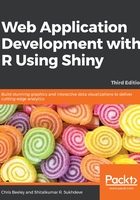
Types of Shiny application
In the first edition of this book, which was based on Shiny 0.6, we described only two types of application. First, a fairly simple Bootstrap-themed interface with input widgets down the left and output (a single page or a tabbed output window) on the right. The second type consisted of custom-built web pages with their own HTML and CSS files. Shiny has developed quite a bit since then, and there are actually many types of Shiny application and many ways of building them. These are as follows:
- Interactive markdown documents with Shiny widgets embedded
- Shiny applications (default CSS, written entirely in R)
- Web pages (for example, custom CSS, HTML, and JavaScript)
- Shiny gadgets
- Flex dashboards
In this chapter, we will be considering the first two: interactive documents and full applications. Chapter 3, Integrating Shiny with HTML, will cover how to build your own web pages containing Shiny applications. Shiny gadgets are tools for R programmers rather than for end users, and they allow R users to explore data and generate graphics and summaries with Shiny interfaces. They will be described further in Chapter 7, Power Shiny. Flex dashboards will be looked at in Chapter 6, Dashboards.